Movie Review – Halloween (1978)
Director : John Carpenter
Year Of Release : 1978
Principal Cast : Donald Pleasence, Jamie Lee Curtis, Nick Castle, Charles Cyphers, Nancy Kyes, PJ Soles, Kyle Richards, Brian Andrews, Tony Moran, Will Sandlin, John Michael Graham, Sandy Johnson.
Approx Running Time : 91 Minutes
Synopsis: On Halloween night of 1963, 6-year old Michael Myers stabbed his sister to death. After sitting in a mental hospital for 15 years, Myers escapes and returns to Haddonfield to kill.
********
It’s difficult to explain just how influential John Carpenter’s 1978 slasher classic, Halloween, was on the horror genre. Atmospheric, largely devoid of outright gore (unlike films today), yet utterly chilling, Halloween became a phenomenon spawing a franchise of sequels and reboots, and propelled filmmakers like Wes Craven (A Nightmare On Elm Street) and Sean Cunningham (Friday The 13th) into carving out a new niche in cinematic myth-making. Carpenter’s superb direction and seductive, atmospheric chiller delivers effective scares and skin-creeping suspense, derived from the menace of a hulking Michael Myers and the relative innocence of the virginal teens depicted in the movie.
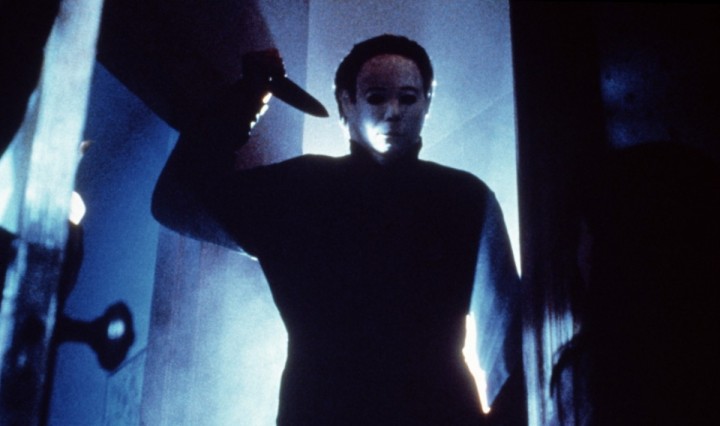 In 1963, on Halloween Night, a young boy by the name of Michael Meyers murders his older sister Judith in cold blood, and spends the next fifteen years locked in an asylum, treated by Doctor Loomis (Donald Pleasence). Following his eventual escape from the hospital, Myers is hell-bent on returning to his home town of Haddonfield; upon doing so, he starts following a young high-school student, Laurie Strode (Jamie Lee Curtis) and her friends, Annie (Nancy Kyes) and Lynda (PJ Soles), with Laurie particularly spooked by the odd man lurking around their neighbourhood. Loomis, hot on Myers’ tail, informs the Haddonfield police chief, Sheriff Brackett (Charles Cyphers), and they wait for the psychopath to make his move. As Halloween night settles over the town, Michael Meyers starts to make her move.
In 1963, on Halloween Night, a young boy by the name of Michael Meyers murders his older sister Judith in cold blood, and spends the next fifteen years locked in an asylum, treated by Doctor Loomis (Donald Pleasence). Following his eventual escape from the hospital, Myers is hell-bent on returning to his home town of Haddonfield; upon doing so, he starts following a young high-school student, Laurie Strode (Jamie Lee Curtis) and her friends, Annie (Nancy Kyes) and Lynda (PJ Soles), with Laurie particularly spooked by the odd man lurking around their neighbourhood. Loomis, hot on Myers’ tail, informs the Haddonfield police chief, Sheriff Brackett (Charles Cyphers), and they wait for the psychopath to make his move. As Halloween night settles over the town, Michael Meyers starts to make her move.
Sex and death have long been terrific bedfellows in the world of horror film-making. Scream touched on this very fact in its parody-esque meta-references to its own genre, realizing that typical horror films featured virginal, or sexed-up teens spending their time figuring out how to sneak off somewhere secret and screw, only to inevitably meet their end at the pointy part of the killer’s weapon. Halloween might be seen as clichéd in today’s remake-reboot world, but for its time was startlingly new and fresh. Sure, at least one character states “I’ll be right back” (heh), all of them forget to turn on the lights when they’re entering a dark room, and Carpenter’s use of POV shots at times representing Meyers’ viewpoint has been copied so many times in the years since, it’s almost chuckle-worthy. But in 1978 this film was as fresh as a daisy and Carpenter’s style was inventive and new; it blew audiences away.
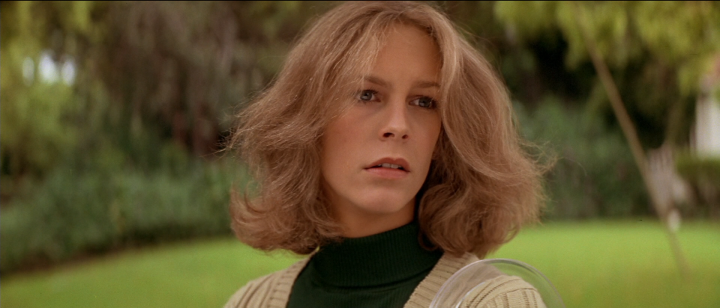 The first-time viewer of Halloween must take into account the era in which it was made. Made for just over $300,000 at the time, it was considerably low-budget by Hollywood standards, and yet thanks to what Carpenter was able to achieve the film raked in over $70m in its theatrical run, an enormous profit and enough to ensure sequels indefinitely. The film remains a startling template for horror in the modern era: although cliches abound, back then they weren’t cliches, and it must be said that as the originator of much of what we take for granted in today’s horror films, Carpenter must be applauded for not only introducing methods of spooking and shocking audiences, but doing it so well the original film holds up supremely well.
The first-time viewer of Halloween must take into account the era in which it was made. Made for just over $300,000 at the time, it was considerably low-budget by Hollywood standards, and yet thanks to what Carpenter was able to achieve the film raked in over $70m in its theatrical run, an enormous profit and enough to ensure sequels indefinitely. The film remains a startling template for horror in the modern era: although cliches abound, back then they weren’t cliches, and it must be said that as the originator of much of what we take for granted in today’s horror films, Carpenter must be applauded for not only introducing methods of spooking and shocking audiences, but doing it so well the original film holds up supremely well.
Halloween is entirely about atmosphere and dread – the anticipation of violence – and thanks to a minimalist approach to editing and framing, coupled with one of the most famous horror scores ever written (aside from Psycho, I’d say Halloween’s score, composed by Carpenter himself, remains the definitive genre masterpiece), succeeds in almost every way. Meyers is portrayed as a hulking, utterly evil, beyond-redemption creature of death and destruction, the antithesis of the teenage characters inhabiting the film. His motivations are simple – to kill people – and his victims are typically defenceless, or physically weaker, than he is himself. It’s a brutal combination of menace and faceless, unstoppable brute force, an implacable enemy who cannot be reasoned with. Carpenter uses Myers’ inherent horrific sense of dread to ratchet up the tension superbly, creating within the indestructibly brutish figure one of the ultimate villains of the age. Although arguably plain in style – Myers wears a blue jumpsuit and a white, emotionless mask throughout the film – his impact has created a legacy that transcends not only the Halloween franchise, but the horror genre overall.
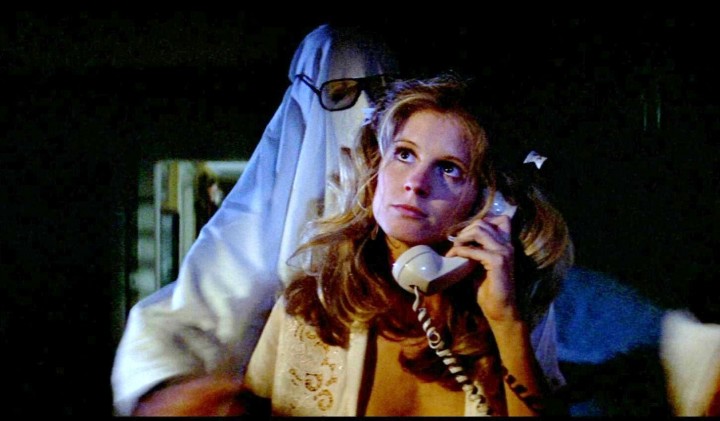 Going up against Myers is Jamie Lee Curtis’ Laurie Strode, perhaps her most famous character and certainly one of her most enduring (so much so, she reprised the role in the H20 sequel), and in her feature film début, is probably the most natural, believable screen heroine these films would produce. Strode represents frailty, deriving strength through adversity, while her on-screen companions, played by Nancy Keys (who can’t act, but looks hot I guess) and PJ Soles (who is hot, and also can’t act) are killed off by invariably brutal means. Although there’s a fairly minimal body count in Halloween, Carpenter isn’t about the acts of violence as much as the amount of tension he can draw out of building up to the moment, of which I must say he’s an absolute master. Although Laurie’s initial feelings about Myers presence don’t justify her sense of self-preservation, as Halloween night wears on and her friends wind up dead, the fight-or-flight jolts kick in, and Curtis has to prove herself worthy of the fight.
Going up against Myers is Jamie Lee Curtis’ Laurie Strode, perhaps her most famous character and certainly one of her most enduring (so much so, she reprised the role in the H20 sequel), and in her feature film début, is probably the most natural, believable screen heroine these films would produce. Strode represents frailty, deriving strength through adversity, while her on-screen companions, played by Nancy Keys (who can’t act, but looks hot I guess) and PJ Soles (who is hot, and also can’t act) are killed off by invariably brutal means. Although there’s a fairly minimal body count in Halloween, Carpenter isn’t about the acts of violence as much as the amount of tension he can draw out of building up to the moment, of which I must say he’s an absolute master. Although Laurie’s initial feelings about Myers presence don’t justify her sense of self-preservation, as Halloween night wears on and her friends wind up dead, the fight-or-flight jolts kick in, and Curtis has to prove herself worthy of the fight.
Although granted top billing, Donald Pleasence’s character of Loomis has decidedly little to do in the film other than spout exposition on Myers and look perpetually fearful; his final act in the film is one of horror’s great bait-n-switches, that of having the killer seemingly dead, but mysteriously un-corpsed a few moment later. Notably, Curtis’ character ends up having only the briefest hands-on battle with Meyers, which was suprising considering I thought Carpenter would throw them together earlier than he ends up doing. Pleasence is a welcome presence in the film, for sure, and so too is Charles Cyphers, as the town’s sheriff, but aside from giving us brief moments away from the Myers/Strode narrative, they don’t do a lot in the end.
As mentioned, Halloween works on anticipatory dread, that sense of unease and tension when you never quite know what’s lurking in the shadows, or going to spring from the dark to scare you. The film contains more than a few jump scares, and they still work wonderfully (even for jaded horror fans such as myself): it’s testament to Carpenter’s skill in framing and editing that he delivers such stunning results. Rudimentary in both scope and production value, the film is surprisingly restricted in locale and narrative depth: the majority of the film occurs on the streets of Laurie’s neighbourhood, while the bulk of the film’s climactic “kill” scenes take place in two houses on opposite sides of a suburban street. Sparse technical production and a largely minimal design of set and location work for the film to add a sense of idyllic simplicity into which Meyers’ evil erupts. Haddonfield could be anywhere, any town, and in that sense Laurie could be any one of us, really. It’s this simplistic deftness of drawing tension from the seemingly mundane that works so beautifully here, and which has been imitated by horror film-makers through the decades since.
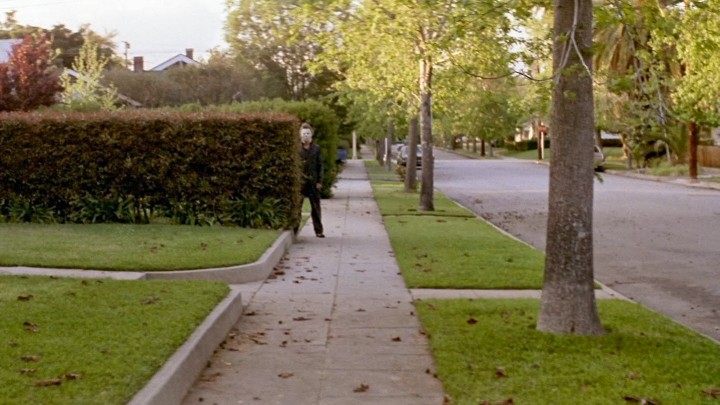 Artful shot composition is key to Halloween’s bloodless aesthetic. The film’s 2.35 aspect gives Carpenter the width of frame to tell two stories at once, at times. Whenever a character is in shot, you’re always checking the other corners of the frame to see if Meyers is going to pop up in the background. The oft-used cliché of a main character having their back turned to the (apparently dead) killer, seemingly oblivious to the fact that the killer suddenly rises up alive again, gets a full workout here, with plenty of those “walk past frame and killer appears in the background” shots featured as well. But it’s the lighting and framing Carpenter gives the film, his use of long takes and a slow build-up of tension through judiciously restrained editing, that gives the film its zing. The whole “he’s behiiiind you” moment of skin-prickling terror reaches its crescendo in Laurie’s showdown with Michael; Halloween wrote the rules of modern horror, and in doing so did it without the use of graphic, in your face gore.
Artful shot composition is key to Halloween’s bloodless aesthetic. The film’s 2.35 aspect gives Carpenter the width of frame to tell two stories at once, at times. Whenever a character is in shot, you’re always checking the other corners of the frame to see if Meyers is going to pop up in the background. The oft-used cliché of a main character having their back turned to the (apparently dead) killer, seemingly oblivious to the fact that the killer suddenly rises up alive again, gets a full workout here, with plenty of those “walk past frame and killer appears in the background” shots featured as well. But it’s the lighting and framing Carpenter gives the film, his use of long takes and a slow build-up of tension through judiciously restrained editing, that gives the film its zing. The whole “he’s behiiiind you” moment of skin-prickling terror reaches its crescendo in Laurie’s showdown with Michael; Halloween wrote the rules of modern horror, and in doing so did it without the use of graphic, in your face gore.
Whereas modern horror tends to spill arterial blood across the frame every few moments to achieve a shock-and-awe approach to the audience, Halloween has almost zero depictions of blood, even though the main character uses a knife in several kill scenes. Aside from the opening sequence of a young Michael killing his sister, and a brief amount of blood seen in Laurie’s end-battle with Myers, the film is devoid of any form of gore. Strangulations are overacted to a degree I felt laughable, but the approach by Carpenter to keep his monster silent, deadly and devoid of human emotion, contrasts against the sexually charged atmosphere of teenage Americana. The nubile young lasses who end up butchered by Meyers are as genre-clichéd as possible – hell, they set the bar, when you think about it – and the film’s often liberal use of focus on bums and boobs is the counterweight to the characters’ inevitable demises. Like I said, sex and death go hand in hand in horror films.
Halloween is a master-class in horror film-making – hell, film-making period. John Carpenter’s ubiquitous scream-queen heroine in Jamie Lee Curtis is wonderful, Michael Myers is a threatening storm-cloud of personified evil, and the technical merits of the film’s visuals, editing, sound, musical score and camerawork are of a quality still unachievable to modern film-makers today. Endlessly imitated and parodied, Halloween is the unequivocal moment cinematic horror changed (for the better?) and considering its budget and age it holds up superbly well.


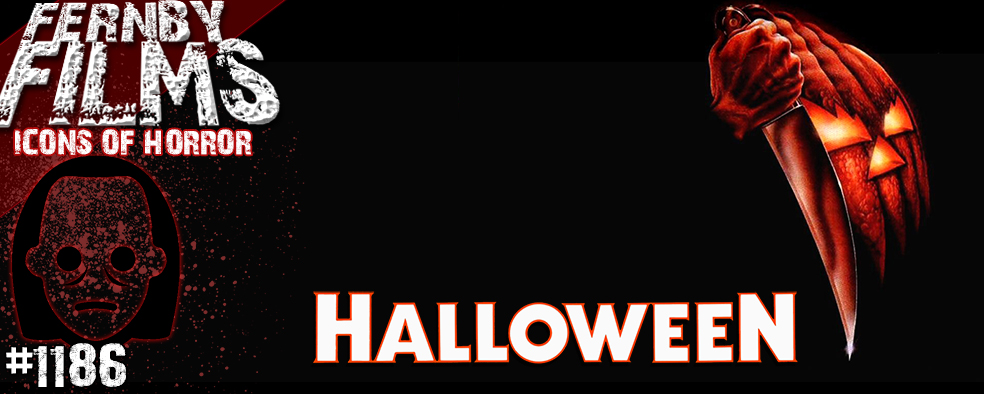






One of the great things about Halloween is something you mentioned, it's restraint. Hardly any gore, all buildup and still a great payoff.
My recent post Thursday Movie Picks: Heist Movies
Absolutely – I was expecting a bloodbath but ended up getting a solid little chiller without copious gore.